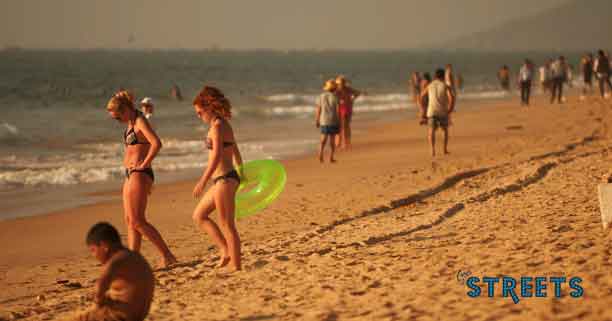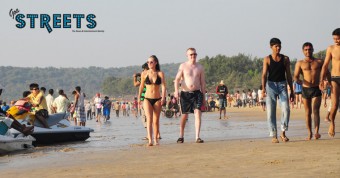The chief minister seems to be saying yes
One of the more tantalizing promises made by Chief Minister Manohar Parrikar during the recent campaign for the two Lok Sabha seats in Goa was to change the CRZ (Coastal Regulation Zone) laws if Narendra Modi becomes the prime minister of India. That has the potential to be a game-changer in touristy Goa because a large amount of the coast is locked up in the CRZ areas, ampoule which restrict construction.
While the CRZ laws have to be amended in parliament, relaxing the laws could be a bonanza for land owners, there builders and tourism operators who dream of monetizing gorgeous beachfront properties with permanent structures. It also has the potential to destroy one of the main things that has made Goa such an attractive tourist destination: pristine beaches.
Just opening up the topic for debate is causing a stir, with some salivating at the prospect and others deeply fearful that our state’s beaches will suffer even more degradation than what they’ve already experienced.
If it had not been for the CRZ restrictions, the Goan coastline – heart of the tourism industry – would have looked vastly different today. First proposed in the early 1980’s by then Prime Minister Indira Gandhi and finally announced in 1991 and further amended in 2011, the CRZ laws restrict all building activity uP to 500 meters from the high-tide line in the coastal areas, and also along river banks.
Nothing is allowed 100 meters from the high-tide line except shacks or coco-huts made of eco-friendly material, while certain structures are permitted from 200 meters onwards till 500 meters, with restrictions in height and FAR (floor area ratio).
But there are hundreds of illegal constructions in the CRZ areas. Almost all of these are ‘old houses’ which existed prior to the CRZ notification of 1991, but which have been ‘extended’ or many a time ‘renovated’ into bigger structures.
Because of the symbiosis between the local panchayat members and villagers, the authorities have turned a blind eye to these illegal constructions. The matter of these constructions, which has been going on in the High Court and elsewhere, has now reached the National Green Tribunal following petitions filed by the Goa Foundation (which had also filed the case against illegal mining in the Supreme Court). The first cases were filed in 1996 and the cases have now been clubbed together.
During visits to the coastal belt in the runup to the recent elections, the chief minister promised traditional fishermen and others residing along the coastal belt whose properties come under the CRZ areas that the BJP would ensure that the Coastal Regulation Zone rules would be amended if Narendra Modi becomes prime minister. The relaxation of CRZ rules has been a long-pending demand of coastal communities, not just in Goa, but elsewhere too.
Calangute MLA Michael Lobo said he has given the proposal to the CM because a lot of people in his constituency have properties in the CRZ areas and are unable to construct anything. The Candolim-Calangute beach belt is also the most visited area by tourists in Goa.
“The CRZ rules were first notified in 1991 and amended in 2011. We want a further amendment and I have given a proposal to the CM which he has promised to take up with the Centre when the BJP forms the new government,” Lobo said.
Explaining the proposal, he said, “The rules say that between 200-500 meters of the high-tide line whoever owns small properties cannot build anything. Only those owning 4,000 sq mts or more are allowed to construct something. This is favourable to outsiders and unfavourable for locals who mostly own small plots.
What is happening now is that outsiders come, buy these small plots and join them to make bigger plots,” he says. “My proposal is that locals should be allowed to build only guest-houses in this zone, and not residences. The height of the structures should also be increased from 9-mts to 12-mts, while the FAR should be increased from 33% to 50%.
Also, all existing structures in this zone which have been built prior to 2013 should also be regularized,” Lobo said.
He said right now people are constructing structures in this zone by bribing local bodies like the panchayats, but with the new amendments, they would be able to construct legally.
But Calangute panchayat leader Joseph Sequeira says the BJP is trying to foolpeople from the coastal communities by saying they will amend the CRZ rules.
Sequeira says the Calangute panchayat has filed a compliance report to the high court in respect of 840 structures, while the Candolim panchayat has filed a compliance report for 640 structures.
Following this regularizing, there is no need for any amendments to the CRZ rules, he says, adding, “The BJP only wants to amend the CRZ rules to benefit big resorts, not Goan fishermen.”
CRZ restrictions in the Calangute- Candolim beach-belt, though resented by many land-owners and residents, are seen by others as a real blessing. Otherwise the scenic beachside land would have long ago been turned into a concrete jungle. Large parts of these two villages have already turned into a sprawling resort city with huge constructions mushrooming up in every available space away from the CRZ zone on the beachside land. It is debatable whether Calangute-Candolim and other popular beaches like Colva, Palolem, Morjim, etc would have continued to remain an attractive destination for tourists if the beachfront had turned into a concrete wasteland.
Though CRZ restrictions are a huge deterrent to those setting up resorts along the beachside land, entrepreneurs are still coming forward to buy land close to the beach, according to sources. The restrictions have meant that the beachside resorts have to compulsorily build only villa-style units, which arguably have in turn added to the aesthetic of the beachfront. People are even buying land in the 100-mts no development zone close to the high-tide line, and then setting up temporary private beach shacks and huts because they fetch good rentals, and also with the hope that one day the CRZ rules would change. Other land owners with big properties have turned to open-air music festivals like Sunburn. Restaurants set up in these properties also do roaring business.
However, the Goa Coastal Zone Management Authority, set up to monitor CRZ violations, has been constantly issuing demolition notices to structures built illegally within CRZ areas, with some resorts in the Morjim area recently being directed to demolish their structures. But the resorts go into appeal and then the matter drags on for years. One thing’s for sure, if amended the CRZ rules should come with a comprehensive strategy for sustainable, planned development that will bring economic development without destroying the beauty of Goa.




